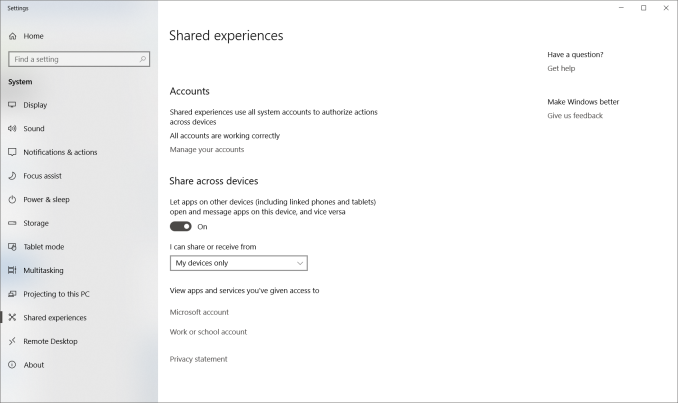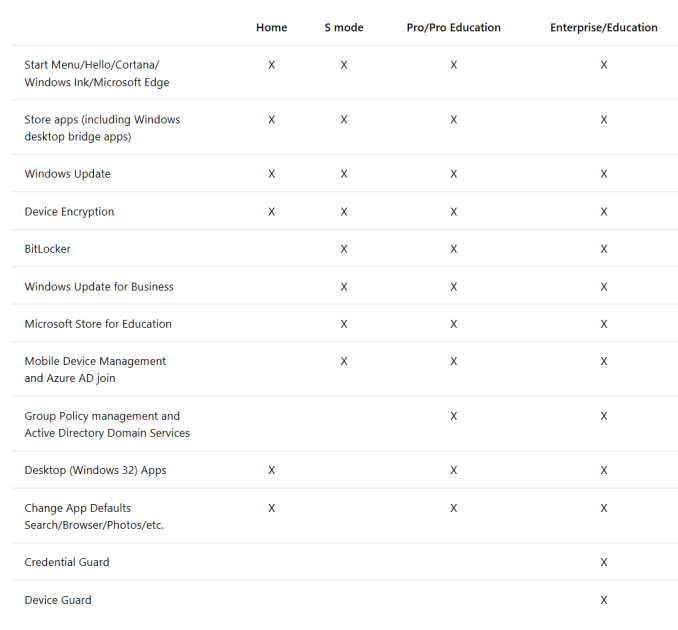The Windows 10 April Update (1803): The Littlest Big Update
by Brett Howse on May 25, 2018 8:00 AM EST- Posted in
- Software
- Operating Systems
- Windows
- Microsoft
- Windows 10
Nearby Share
One feature that should be very useful to certain people is Nearby Share. This lets you quickly and easily share files between people from PC to PC, without having to send an email or use a messaging app as the transfer tool. Nearby Share works over Bluetooth or Wi-Fi, and will use Wi-Fi as the preference. In an office, this was something done via a USB drive most recently, but with wireless and Bluetooth in all modern laptops, it makes sense to leverage that to avoid a step.
It should be very useful in certain situations, and isn’t tied to an account so you can send to any nearby device. The receiver will have the option of accepting the file. It’s not on by default, but can be toggled on when needed. It’s definitely something you’d not want to leave on.
Easy Bluetooth
Windows 10 now supports a simpler Bluetooth pairing process for some devices which lets you pair devices with a single click. You’ll get a pop-up notification asking if you want to pair a device, and if you say yes, it’s all setup. Devices have to support this though, and ones that require PINs are not going to work with a single click setup.
Windows 10 S Mode
Windows 10 S launched with the Surface Laptop as its first device to offer the constrained version of Windows 10 that restricts users to only running apps from the Store. The idea was to keep people from harming themselves, and to keep performance levels where they should be, by not allowing people to just install whatever they want, and to keep apps in packages that allow for easy removal and less items running at startup. This is pretty much how any modern smartphone works of course, but the downside to it on Windows 10 was that the Microsoft Store is not known as one of the key selling features, so uptake and usuage of Windows 10 S had to be pretty small. With the April Update, this is replaced by Windows 10 in S Mode, which is just a setting that can be enabled on any PC to make it like Window 10 S was. It'll still likely never get used, but it's a much better solution than another version of the OS just for this purpose. There's reasons you'd want this of course - education being a great example - but the average consumer is choosing Windows for the legacy application support, so this new model is definitely the better way to handle it.
The drawback is that S Mode is a one-way setting at the moment. A machine can be set in S mode when imaged using an unattended.xml file and dism, but if it's set back to regular Windows 10, there's not a way to switch back and forth.












161 Comments
View All Comments
ಬುಲ್ವಿಂಕಲ್ ಜೆ ಮೂಸ್ - Saturday, May 26, 2018 - link
I wish the staff would openly discuss the problem with Microsofts DRM instead of deleting my posts without commentYES, it may be against the "LAW" to discuss getting around DRM but those Laws only help Criminals who wrote the Law
A permanent backdoor into everyones computer IS a matter of National and Personal Security
Bill Gates once asked for an open discussion on security
When are you willing to actually have it ?
I believe James Comey even asked for an open discussion on the problems affecting National Security such as Encryption Backdoors
I am ready for an honest open discussion
AnandTech is definitely NOT Ready!
Be a part of the solution, instead of the problem
ChristopherFortineux - Friday, June 8, 2018 - link
Being from India yourself. You know better than breaking the law discussing breaching the DRM. Why you keep mentioning it on random comments is redundant. Also, "Bullwinkle J. Moose" LOLAzurael - Saturday, May 26, 2018 - link
I think this one went better than FCU. No complete reinstalls required yet, but one of the machines I manage still won't install it. Still, I'm not going to hold it against Microsoft because I insist on running all of my EFI-capable machines _in_ EFI boot mode and some of the early UEFI implementations (2007-2010ish) are flakey as hell. On this particular (personal) machine, I don't think the fact that the ESP is shared with a Linux install is helping, Microsoft seem to like a lot of free space on it to successfully install, even though their default partition map creates an ESP about half the size of the 'standard' 256MB...Sill, about 20 machines and no other issues, as I said, much better than FCU! I had to reinstall 3 at work last time today round... One thing I've learned is that it really isn't worth trying to diagnose issues with the updater. If you have to try and run it more than twice, a clean install is invariably quicker...
landerf - Saturday, May 26, 2018 - link
The amount of hoops I've had to jump through to replace homegroup functionality is mind boggling and I'm still not sure it will keep working the next time I reboot and all the solutions are far less secure than homegroup.coburn_c - Sunday, May 27, 2018 - link
They turned last access time stamp back on. I can't understand why, considering the i/o performance hit of the latest security patches and the fact that it has been off for the last decade.exactopposite - Sunday, May 27, 2018 - link
i have tried the update on 4 machinesRyzen x370 syste updated with no problem
Kaby lake desktop updated ok but network settings changed which prevented network shares form working. It was a simple fix but annoying
Kaby lake HTPC and Broadwell laptop both refuse to install it. The install almost completes but then uninstalls and rolls back
lfred - Monday, May 28, 2018 - link
What fix did you use? shares keeps disconnecting from time to time here?ChristopherFortineux - Friday, June 8, 2018 - link
No luck with clean install?Schmide - Sunday, May 27, 2018 - link
11 pages and a full article and no mention of the fact that they took away Workgroup?For shame
ChristopherFortineux - Friday, June 8, 2018 - link
What did you still need Workgroup for? The issue is it has become unnecessary for most things. Share for networks is already built into Windows 10. File storage is built into the OS with OneDrive. There are superior alternatives to sharing over network.